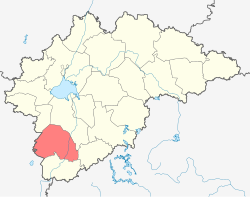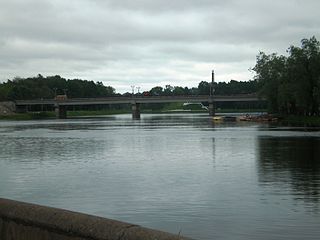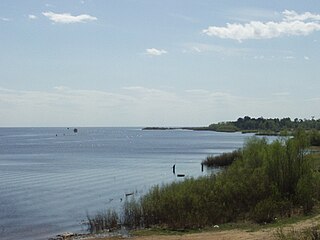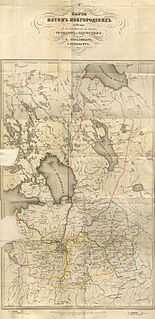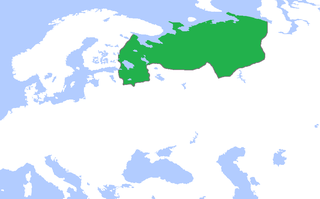
Staraya Russa is a town in Novgorod Oblast, Russia, located on the Polist River, 99 kilometers (62 mi) south of Veliky Novgorod, the administrative center of the oblast. Its population has steadily decreased over the past years, going from 41,538 recorded in the 1989 Census to 35,511 in the 2002 Census to 31,809 in the 2010 Census.
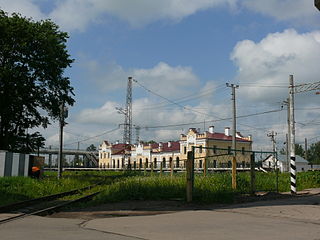
Chudovo is a town and the administrative center of Chudovsky District in Novgorod Oblast, Russia, located on the Kerest River. Population: 15,397 (2010 Census); 17,434 (2002 Census); 17,982 (1989 Census).
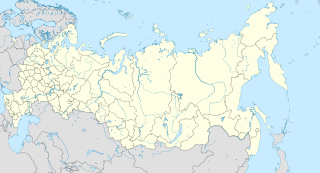
Kholm is a town and the administrative center of Kholmsky District in Novgorod Oblast, Russia, located at the confluence of the Lovat and Kunya Rivers, 77 kilometers (48 mi) north of Toropets, 93 kilometers (58 mi) southwest of Staraya Russa, and 201 kilometers (125 mi) south of Veliky Novgorod, the administrative center of the oblast. Population: 3,830 (2010 Census); 4,325 (2002 Census); 4,849 (1989 Census).

Malaya Vishera is a town and the administrative center of Malovishersky District in Novgorod Oblast, Russia. Population: 12,461 (2010 Census); 14,182 (2002 Census); 15,647 (1989 Census).

Pestovo is a town and the administrative center of Pestovsky District in Novgorod Oblast, Russia, located in the Valdai Hills on the Mologa River. Population: 15,903 (2010 Census); 15,990 (2002 Census); 15,941 (1989 Census).

Uglovka is an urban locality in Okulovsky District of Novgorod Oblast, Russia, located on the Moscow – Saint Petersburg Railway. Municipally, it is incorporated as Uglovskoye Urban Settlement in Okulovsky Municipal District, one of the three urban settlements in the district. Population: 3,064 (2010 Census); 3,553 (2002 Census); 4,041 (1989 Census).

Parfino is an urban locality and the administrative center of Parfinsky District of Novgorod Oblast, Russia, located along the Lovat River, 20 kilometers (12 mi) east of Staraya Russa. Municipally, it is incorporated as Parfinskoye Urban Settlement, the only urban settlement in the district. Population: 7,492 (2010 Census); 8,446 (2002 Census); 8,299 (1989 Census).

Batetsky District is an administrative and municipal district (raion), one of the twenty-one in Novgorod Oblast, Russia. It is located in the northwest of the oblast and borders with Luzhsky District of Leningrad Oblast in the northwest, Novgorodsky District in the east, and with Shimsky District in the south. The area of the district is 1,600 square kilometers (620 sq mi). Its administrative center is the rural locality of Batetsky. District's population: 6,335 (2010 Census); 6,996 ; 7,622 (1989 Census). The population of the administrative center accounts for 35.6% of the district's total population.

Demyansky District is an administrative and municipal district (raion), one of the twenty-one in Novgorod Oblast, Russia. It is located in the south of the oblast and borders with Krestetsky District in the north, Valdaysky District in the northeast, Firovsky District of Tver Oblast in the southeast, Ostashkovsky District of Tver Oblast in the south, Maryovsky District in the southwest, Starorussky District in the west, and with Parfinsky District in the northwest. The area of the district is 3,200 square kilometers (1,200 sq mi). Its administrative center is the urban locality of Demyansk. Population: 13,001 (2010 Census); 16,020 ; 18,488 (1989 Census). The population of Demyansk accounts for 41.3% of the district's total population.
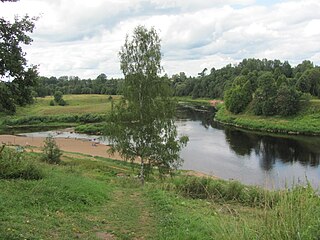
Kholmsky District is an administrative and municipal district (raion), one of the twenty-one in Novgorod Oblast, Russia. It is located in the south of the oblast and borders with Poddorsky District in the north, Maryovsky District in the east, Andreapolsky District of Tver Oblast in the southeast, Toropetsky District of Tver Oblast in the south, Loknyansky District of Pskov Oblast in the southwest, and with Bezhanitsky District of Pskov Oblast in the northwest. The area of the district is 2,178.69 square kilometers (841.20 sq mi). Its administrative center is the town of Kholm. Population: 6,177 (2010 Census); 7,712 ; 9,174 (1989 Census). The population of Kholm accounts for 62.0% of the district's total population.

Maryovsky District is an administrative and municipal district (raion), one of the twenty-one in Novgorod Oblast, Russia. It is located in the south of the oblast and borders with Demyansky District in the north, Ostashkovsky and Penovsky Districts of Tver Oblast in the southeast, Andreapolsky District of Tver Oblast and Kholmsky District in the southwest, Poddorsky District in the west, and with Starorussky District in the northwest. The area of the district is 1,800 square kilometers (690 sq mi). Its administrative center is the rural locality of Maryovo. District's population: 4,673 (2010 Census); 5,711 ; 6,835 (1989 Census). The population of Maryovo accounts for 49.2% of the district's total population.

Moshenskoy District is an administrative and municipal district (raion), one of the twenty-one in Novgorod Oblast, Russia. It is located in the east of the oblast and borders with Khvoyninsky District in the north, Pestovsky District in the east, Lesnoy District of Tver Oblast in the southeast, Udomelsky District of Tver Oblast in the south, and with Borovichsky District in the west. The area of the district is 2,568 square kilometers (992 sq mi). Its administrative center is the rural locality of Moshenskoye. Population: 7,309 (2010 Census); 9,486 ; 10,679 (1989 Census). The population of Moshenskoye accounts for 34.3% of the district's total population.

Parfinsky District is an administrative and municipal district (raion), one of the twenty-one in Novgorod Oblast, Russia. It is located in the center of the oblast and borders with Krestetsky District in the north, Demyansky District in the southeast, and with Starorussky District in the southwest. The area of the district is 1,591 square kilometers (614 sq mi). Its administrative center is the urban locality of Parfino. Population: 14,395 (2010 Census); 16,485 ; 17,650 (1989 Census). The population of Parfino accounts for 52.0% of the total district's population.
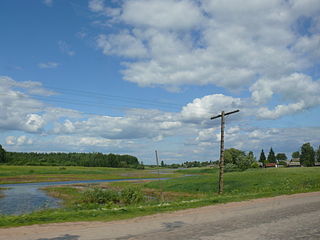
Shimsky District is an administrative and municipal district (raion), one of the twenty-one in Novgorod Oblast, Russia. It is located in the west of the oblast and borders with Batetsky District in the north, Novgorodsky District in the northeast, Starorussky District in the southeast, Volotovsky District in the south, Soletsky District in the southwest, Strugo-Krasnensky and Plyussky Districts, both of Pskov Oblast, in the west, and with Luzhsky District of Leningrad Oblast in the northwest. The area of the district is 1,836 square kilometers (709 sq mi). Its administrative center is the urban locality of Shimsk. Population: 11,750 (2010 Census); 13,312 ; 13,477 (1989 Census). The population of Shimsk accounts for 33.1% of the district's total population.
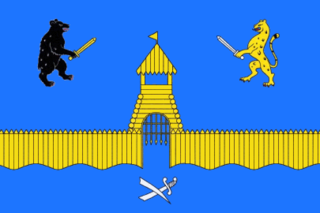
Soletsky District is an administrative and municipal district (raion), one of the twenty-one in Novgorod Oblast, Russia. It is located in the west of the oblast and borders with Shimsky District in the north, Volotovsky District in the east, Dnovsky District of Pskov Oblast in the south, Porkhovsky District of Pskov Oblast in the southwest, and with Strugo-Krasnensky District of Pskov Oblast in the west. The area of the district is 1,400 square kilometers (540 sq mi). Its administrative center is the town of Soltsy. Population: 15,714 (2010 Census); 18,626 ; 20,011 (1989 Census). The population of Soltsy accounts for 64.2% of the district's total population.

Starorussky District is an administrative and municipal district (raion), one of the twenty-one in Novgorod Oblast, Russia. It is located in the southwest of the oblast and borders with Parfinsky District in the east, Demyansky and Maryovsky Districts in the southeast, Poddorsky District in the southwest, Volotovsky District in the west, and with Shimsky District in the northwest. From the north, the district is limited by Lake Ilmen. The area of the district is 3,111 square kilometers (1,201 sq mi). Its administrative center is the town of Staraya Russa. Population: 15,063 (2010 Census); 16,214 ; 18,505 (1989 Census).

Volotovsky District is an administrative and municipal district (raion), one of the twenty-one in Novgorod Oblast, Russia. It is located in the southwest of the oblast and borders with Shimsky District in the north, Starorussky District in the east, Poddorsky District in the south, Dedovichsky District of Pskov Oblast in the southwest, Dnovsky District of Pskov Oblast in the west, and with Soletsky District in the northwest. The area of the district is 995 square kilometers (384 sq mi), which makes it the smallest district in the oblast.= Its administrative center is the rural locality of Volot. District's population: 5,493 (2010 Census); 6,106 ; 7,058 (1989 Census). The population of Volot accounts for 40.7% of the district's total population.

Maryovo is a rural locality and the administrative center of Maryovsky District of Novgorod Oblast, Russia, located in the south of the oblast, on the Maryovka River, a tributary of the Pola River. Municipally, it is the administrative center of Maryovskoye Rural Settlement. Population: 2,297 (2010 Census); 2,631 (2002 Census); 2,797 (1989 Census).

Poddorye is a rural locality and the administrative center of Poddorsky District of Novgorod Oblast, Russia, located in the southwest of the oblast, on the Redya River, a left tributary of the Lovat River. Municipally, it is the administrative center of Poddorskoye Rural Settlement. Population: 1,860 (2010 Census); 1,957 (2002 Census); 2,122 (1989 Census).

Volot is a rural locality and the administrative center of Volotovsky District of Novgorod Oblast, Russia, located in the west of the oblast on the banks of the Psizha River. It also serves as the administrative center of Volot Settlement, one of the three settlements into which the district is administratively divided. Municipally, it is the administrative center of Volot Rural Settlement. Population: 2,236 (2010 Census); 2,329 (2002 Census); 2,485 (1989 Census).
